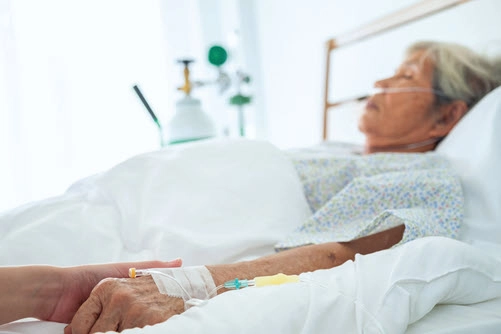MDS Alert
Care Plan Accordingly for Long-Term COVID and Post-COVID Conditions
You will likely continue to encounter more residents with serious complications after COVID infection. With the contagiousness of the delta variant, if you aren’t already caring for residents who have survived COVID-19 but are still struggling with its long-term effects, you may do so soon. The symptoms of long-haul COVID-19 are myriad and can really interfere with daily life and impair activities of daily living (ADL). Various studies show that many people who have been infected with COVID-19 have long-term symptoms. One study in Italy showed that 87 percent of patients in the sample size (all of whom were hospitalized with COVID-19) still had physician-confirmed symptoms two months later. (Read the study here https://jamanetwork.com/journals/jama/fullarticle/2768351). Other studies note that even people who had mild cases may have long-term symptoms. In a small study conducted in Washington, which followed people (not in nursing homes) who were infected with COVID-19 but not hospitalized, some people who were not sick enough to receive hospital treatment still had trouble with their ADL. “With 57.8 million cases worldwide, even a small incidence of long-term debility could have enormous health and economic consequences,” says corresponding author Helen Y. Chu, MD, MPH, who works in the division of allergy and infectious diseases in the Department of Medicine at University of Washington. This study was published in January; the worldwide caseload has now surpassed 200 million, as of publication. (Read the study here https://jamanetwork.com/journals/jamanetworkopen/fullarticle/2776560.) Consider Interventions for Common Symptoms Some of the common symptoms of long-haul COVID-19 include fatigue, brain fog or cognitive impairment, diarrhea, various localized pain, according to the Centers for Disease Control and Prevention (CDC). Officially, long-term COVID describes conditions where COVID-19 symptoms last four or more weeks beyond infection. “Healthcare professionals and patients are encouraged to set achievable goals through shared decision-making and to approach treatment by focusing on specific symptoms (e.g., headache) or conditions (e.g., dysautonomia); a comprehensive management plan focusing on improving physical, mental, and social wellbeing may be helpful for some patients,” the CDC says. When care planning, consider how these symptoms will affect the resident’s ADL. Will they need more or different support or assistance to get dressed? Will they need different food to ease residual gastrointestinal upset? If any of a resident’s medications are adjusted to try to compensate for the increased pain, are any physicians and pharmacists in agreement that there are no contraindications? Although you may not need to conduct additional formal assessments, it could be a useful measure of resident care to include in the care plan when staff will check in with residents about how they’re feeling or what additional support they might need. If they feel increased anxiety, care planning calming music or soothing scents could be warranted. Be Transparent Residents may also be struggling with increased depression, either as a direct result of COVID-19 infection or from the necessary isolation or from lingering symptoms. While staff are used to reassuring residents and trying to ease their emotional suffering, COVID-19 continues to present a gulf that is hard for medical professionals to cross. If a resident has lingering symptoms that they’re living with, the symptoms may be attributable to COVID-19, but they may instead be a result of another condition. Validating the resident’s feelings and witnessing their worries may be helpful A doctor’s advice to other doctors is to be honest and be transparent. “Be transparent with patients. Admit that there is a lot that we don’t know about post-COVID symptoms and recovery. We are really the champions of evidence-based care,” said Alex Vosooney, MD, the chair for the subcommittee on clinical recommendations and policies for the American Academy of Family Physicians, in a June Clinician Outreach and Communication Activity (COCA) call. But above all, “Adhere to our oath as clinicians to do no harm for our patients. Validate what your patient is experiencing,” Vosooney said. “It’s a frustrating process for your patient to feel unwell and not like themselves, but not necessarily have a visible problem that they can show the world.”

MDS Alert
- Staffing:
Know Your Obligations Around Now-Mandatory COVID-19 Vaccinations
In protecting seniors, CMS risks further exacerbating the chronic staffing issues in long-term care. The [...] - Compliance and Safety:
Beware Fake Vaccination Cards
With the Food and Drug Administration issuing full approval for one COVID-19 vaccine, the incidence [...] - COVID-19:
Care Plan Accordingly for Long-Term COVID and Post-COVID Conditions
You will likely continue to encounter more residents with serious complications after COVID infection. With [...] - Surveys and Compliance:
Know the Intricacies of Facility Closure Regulations
Amidst high season for natural disasters and a drop in business due to COVID, avoid [...] - Reader Questions:
Look for 5-Star Preview Report Via CASPER
Question: How do I access my facility’s 5-star preview report? North Dakota Subscriber Answer: “To [...] - Reader Questions:
Residents May Receive Boosters Soon
Question: What do I need to know about a potential third booster COVID-19 vaccination for [...] - Reader Questions:
Don’t Count Closing the Door for Car Transfer
Question: I am trying to decide how to code Section GG for a resident who [...] - Reader Questions:
Beware HIPAA Rules for Electronic Faxes
Question: Our facility sometimes works with other institutions that use electronic faxing for medical records. [...]

